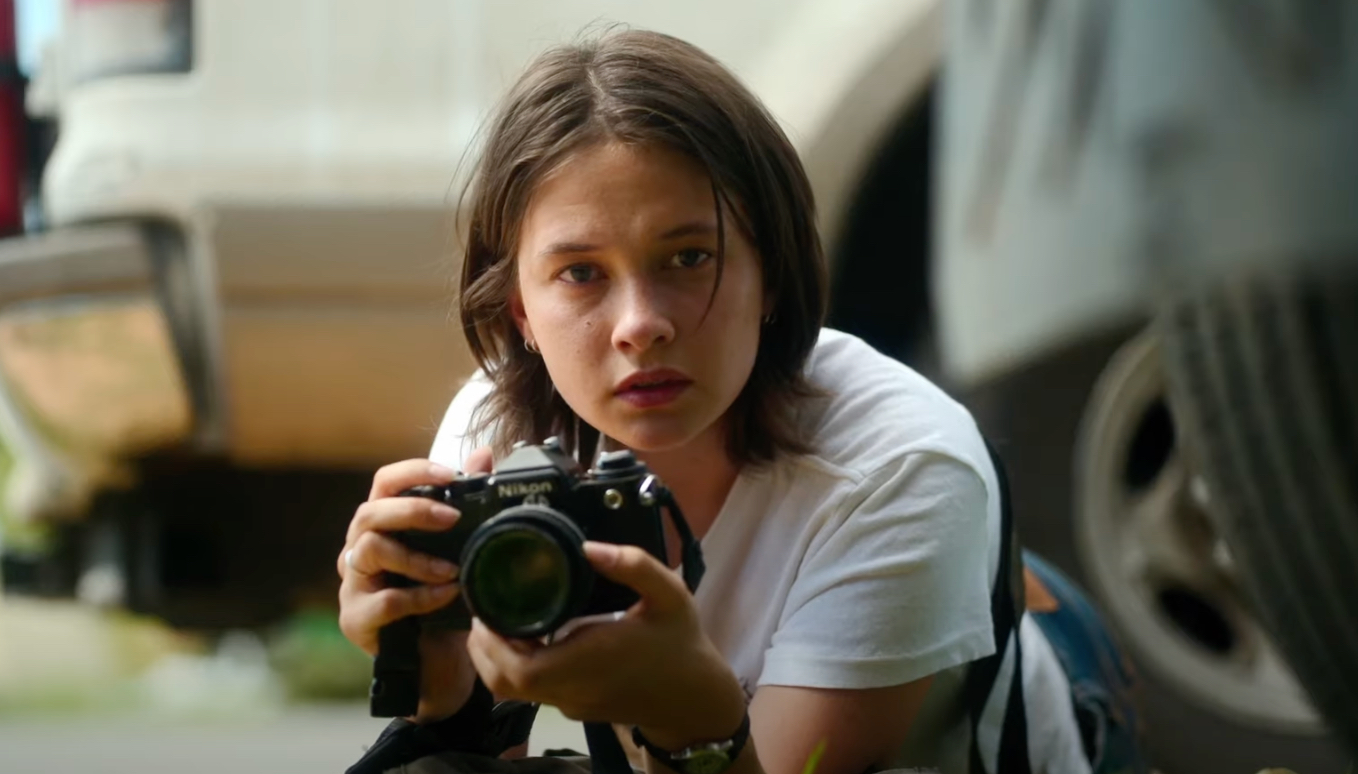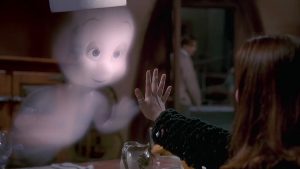
This article contains major Civil War spoilers.
It’s the smiles that ultimately get to me. The entire, deafening finale of Civil War is meant to disturb as secessionist soldiers storm the nation’s capital, obliterating enemy combatants and U.S. landmarks in the same breath. Their foes, the few remaining armed forces loyal to a failed American dictator, are hardly meant to be sympathetic. And yet, it’s impossible to not shudder at the sight of the Lincoln Memorial reduced to rubble or unarmed bureaucrats being executed on the carpeted floors of the West Wing.
The whole sequence crescendos into the inevitable. We see what happens when a strongman’s strength crumbles. The unnamed President of the United States (Nick Offerman), who we’re teased dropped missiles on American citizens and executed journalists across the District of Columbia, is dragged from beneath the Resolute Desk pleading for his life. His final words to be repeated throughout the ages, thanks to our journalist hero (Wagner Moura), are simply, “Please don’t let them kill me.”
They of course do.
All of it has an air of brutal, cynical practicality. Yet it’s how writer-director Alex Garland chooses to frame his last minutes of Civil War which haunt and raise a multitude of intriguing questions. While Joel gets the quote, the person who will savor the images that will echo into eternity is Jessie (Cailee Spaeny), a once green war photographer whose life is now bathed in the color red. Moments earlier she was so eager to photograph the assault on the White House that she stepped in the line of fire, getting her mentor Lee (Kirsten Dunst) killed in the process. But by this point, Jessie is no longer looking away. In fact, she takes several photos of Lee’s death before leaving her idol crumpled in the hall. She then walks into the Oval Office and gets The Shot. The moment a president dies. Sic semper tyrannis.
That, plus the grinning assassins posing for a picture over their quarry, are the final images Civil War fades out on, and much like Jessie’s evolution from cub reporter to steely war zone veteran, it asks the audience to ponder where Garland’s grim prophecy for America’s future is going.
Jessie’s Transformation
Star Cailee Spaeny certainly has given the future beyond Civil War’s ending some thought. When we catch up with her ahead of the movie’s wide release, she notes the contrast between Jessie and Lee’s actions in the film. While war-weary Lee is introduced as colder than any of the reporters who compose Civil War’s quartet of heroes, it doesn’t bear fruit. She can snark “what do you think?” to the painfully young Jessie when the latter asks if Lee would take her photo should she die. But when Lee’s own mentor Sammy (Stephen McKinley Henderson) is killed, Lee both takes the picture and then deletes it. And the conundrum of doing so visibly eats away at her conscience until she finally likewise is gunned down.
“I know when Kirsten was filming that scene with Sammy that there were lots of different versions of her deleting it, not deleting it,” Spaeny reveals, “being very emotional and not being emotional at all.” Garland’s choice to finally have Lee break down from the loss invites audiences into seeing the limits of striving for neutrality; it also asks you to make a contrast of Jessie not only taking a photo of Lee’s death, but being able to compartmentalize the shock and go on with her job.
When asked if she thinks Jessie would herself delete Lee’s death photos, Spaeny points out that it was taken with an actual film camera, so she’ll have some physical form of it. And in Spaeny’s mind, she’d never destroy it.
“I don’t think she published it but I do think she would keep it,” the actor says. “I think she’ll always keep that with her. I don’t think she’d ever get rid of it.”
The juxtaposition of this is striking. Obviously, Jessie is at the dawn of her career and is only beginning to resemble the iron-willed Lee we knew throughout Civil War. However, the hint of a generational difference between Lee and Jessie is distinct. One of them came up in a world before America destroyed itself from the inside, and she could not forget it. Thus a photo of her mentor’s body (after he died saving her life, no less) becomes unbearable. The other not only may find the ability to keep the photo but is also able to bury the feeling away and take several more life-changing portraits. One of a dictator’s assassination, and the next of his subsequent still life.
The smiling faces of big game hunters who bagged the ultimate prize is unmistakable, and the birth of the new America that Jessie’s pictures capture is nothing like the one remembered by the old guard. Or their viewers.
There Is No Rebuilding This Democracy
When we spoke with Garland earlier this week, he was bluntly skeptical about the critique among some critics that Civil War is afraid of making a political statement.
“It’s just complete bullshit,” Garland says. “The thing is the film may be political, it just may not be political in the way they want it to be political.”
We tend to agree. While the film does not chronicle how its civil war began, the breadcrumbs are the size of matzo balls when Offerman’s president indicates a Trumpian level of self-aggrandizement and boastfulness in the first scene. As soon as he claims that an alleged defeat of the Western Forces marks “the greatest victory in the history of all military campaigns,” any viewer whose read headlines in the last nine years should be clued into who this guy is emulating; and if not then certainly after they hear about his disdain for the press and the FBI.
The movie, however, is not about Donald Trump or the specific policies the once (and possibly future) POTUS pursues. It’s about an America that let him get so far; an America that’s become so divided that (even more) people are dying in the streets. Some are killing for an authoritarian, others to stop him, and many others simply because they can. When it’s over, the pile of bodies looks indistinguishable. Civil War, in a nutshell, is a bright neon sign which reads: This is the road you’re on. Like what you see? And that byway will travel past Trump, should he regain power or not.
Earlier in Civil War, Sammy correctly predicts that Offerman’s American dictator will disappoint in his final moments. “They’re always lesser men than you think [at the end of their lives],” Sammy says while drawing comparisons to Benito Mussolini, Muammar Gaddafi, and Nicolae Ceausescu. All three men were dictators who were overthrown, and all three met brutal, pitiful ends.
Yet with the exception of the country that was simultaneously being “liberated” (or conquered) by Allied Forces when Mussolini was butchered by his former supporters, their collapses did not mean a return to stability or peace. Within a year of Romanian dictator Ceausescu and his wife being tried and executed on the spot before a dubious military court in 1989, the National Salvation Front, which replaced Ceausescu’s Communist authoritarian regime, was embroiled in a brutal crackdown of violent protests during the June 1990 Mineriad (and this was also after sectarian violence and killing sprees broke out in the Transylvania region between those ethnically Romanian and those ethnically Hungarian).
The death of Gaddafi, meanwhile, was shortly followed by the Second Libyan Civil War, which ignited in part because of massive religious sectarian violence in the region, including the infamous attack by Islamist militants on an American diplomatic compound in Benghazi that left four Americans dead, including the U.S. ambassador to Libya.
In other words, order is rarely restored by killing your enemies, and nations that descend into a civil war where even vile dictators are rightfully overthrown do not have an instant light at the end of the tunnel. When a French mob shook off the yoke of monarchy during the French Revolution, democratic ideals quickly gave way to a bloodthirsty Reign of Terror. That, in turn, was followed by the rise of another king by a different title, the French Emperor Napoleon Bonaparte. And the aforementioned “sic semper tyrannis” is often apocryphally credited to Marcus Junius Brutus after he and other conspirators assassinated Julius Caesar.
While Brutus likely did not say it, Caesar was undeniably siphoning off the powers of the (elite and insulated) Roman senate and had already declared himself dictator for life. Ask Brutus about what happened next and if Rome’s transition from republic to empire was thwarted.
If U.S. dysfunction gets to the point where a tyrannical president needs to be dragged trembling from beneath the Resolute Desk, then it is already too late. Not only is the Lincoln Memorial in ruin, but so is the union that that president sought to preserve.
In the same scene where the prescient Sammy guesses Offerman’s ending, he also muses the Western Forces (and maybe the so-called Florida Alliance?) will turn on each other nearly as soon as they get to D.C. The union of strange bedfellows like Texas and California is a fractious and presumably finite one. If the U.S. gets to the point where tanks are rolling down Pennsylvania Avenue—either as an act of war or military showmanship by a strongman—the game is over. You cannot put the toothpaste back in the bottle, and the idea of a functioning, stable American republic will not return.
The next generation will already have too much blood in its mouth. And if those smiles are anything to go by, we might start to like it there.
Civil War is in theaters now.
The post Civil War Ending Reveals What the ‘Bleakest Timeline’ Would Really Look Like appeared first on Den of Geek.





